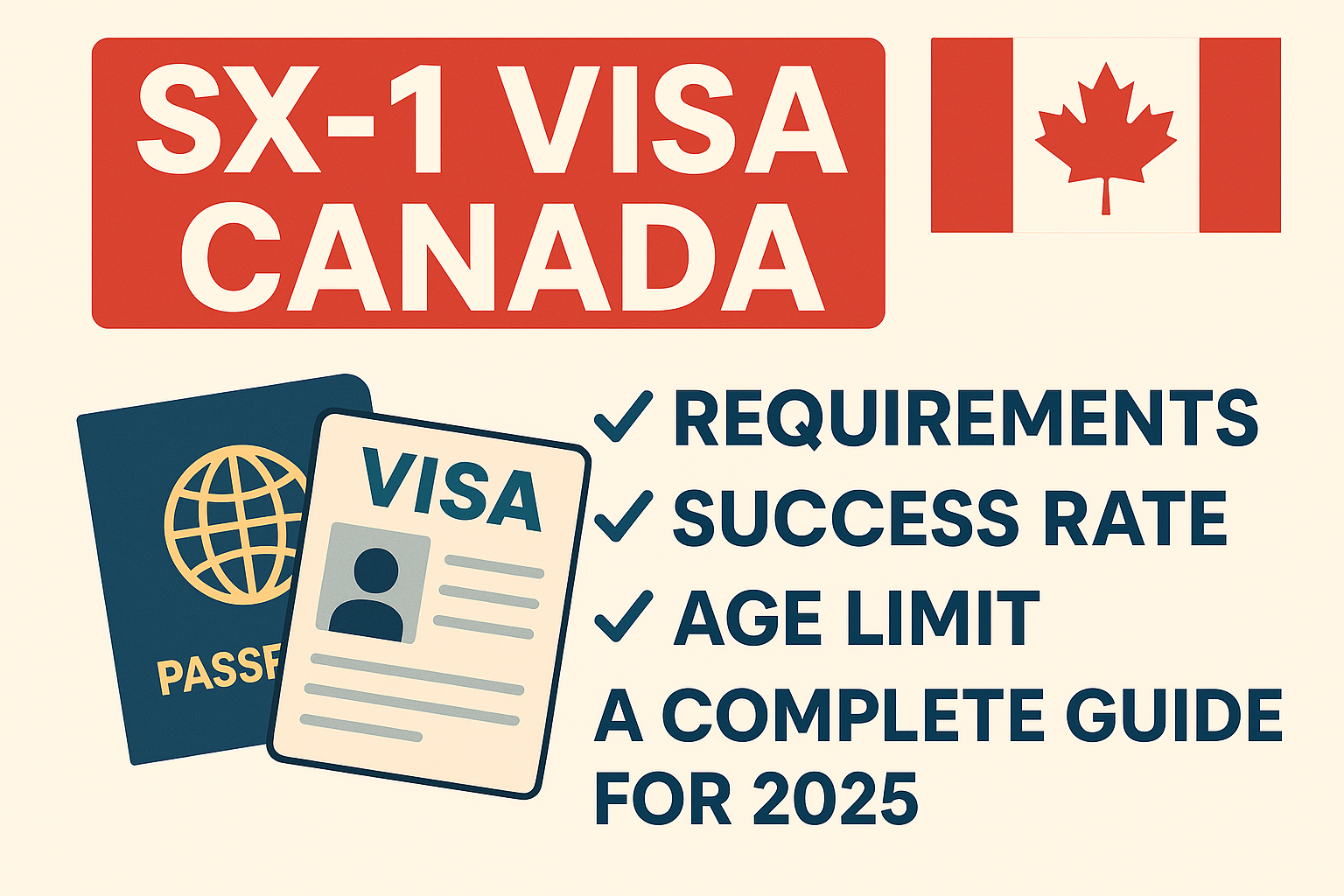
Canada has long been a beacon for international students seeking quality education and global exposure. Among the various visa options available, the SX-1 visa stands out for those aiming to undertake short-term studies in the country. Whether you’re an aspiring entrepreneur, a professional looking to upskill, or someone keen on experiencing Canada’s educational landscape without a long-term commitment, the SX-1 visa could be your gateway.
In this detailed guide, we’ll delve into the intricacies of the SX-1 visa, covering its requirements, success rate, age considerations, application process, and more. Let’s embark on this informative journey.
The SX-1 visa is a temporary resident visa issued by the Canadian government, allowing international students to pursue short-term courses in Canada. Unlike the standard study permit, which caters to programs longer than six months, the SX-1 visa is tailored for courses that last six months or less.
Key Features:
- Duration: Up to 6 months.
- Purpose: Short-term studies, often in business or entrepreneurship.
- Work Rights: No work permit; employment is not permitted.
- Post-Study Stay: No extension; must leave Canada upon course completion.
This visa is ideal for individuals seeking to enhance their skills or knowledge through short courses without the intention of long-term settlement or employment in Canada.
Eligibility Requirements for the SX-1 Visa
To ensure a successful application, it’s crucial to meet the following criteria:
1. Acceptance into a Canadian Institution
Applicants must secure an official admission letter from a recognized Canadian educational institution offering short-term programs. It’s essential to verify that the institution is approved by the Canadian government and that the course aligns with the SX-1 visa requirements.
2. Proof of Financial Support
Demonstrating financial stability is paramount. Applicants should provide evidence of sufficient funds to cover:
- Tuition fees.
- Living expenses during the stay.
- Return transportation costs.
Acceptable proofs include bank statements, sponsorship letters, or scholarship confirmations.
3. Health and Medical Insurance
Given the temporary nature of the stay, applicants must obtain health and medical insurance valid for the entire duration in Canada. This ensures access to necessary healthcare services during the study period.
4. Strong Ties to Home Country
To assure immigration officers of the intent to return home post-study, applicants should:
- Highlight family ties or responsibilities.
- Provide evidence of employment or business commitments.
- Demonstrate property ownership or other significant connections to their home country.
5. Clean Criminal Record
A police clearance certificate is typically required to confirm the applicant’s good conduct and absence of criminal history.
6. Valid Passport
The passport should be valid for the entire duration of the intended stay in Canada.
Age Limit Considerations
One of the notable aspects of the SX-1 visa is its flexibility regarding age. There is no specific age restriction for applicants. This inclusivity allows individuals from various age groups to pursue short-term studies in Canada.
However, it’s worth noting that younger applicants might have a slight advantage, as they are often perceived as more adaptable and likely to benefit from the educational experience. Nonetheless, age is just one of many factors considered during the application process.
Success Rate of the SX-1 Visa
Understanding the likelihood of visa approval is crucial for prospective applicants. The success rate for the SX-1 visa has been reported to be around 60% to 70%, indicating a relatively favorable outcome for well-prepared applications.
Factors influencing the success rate include:
- Completeness and accuracy of the application.
- Strength of ties to the home country.
- Financial stability.
- Clarity of the study plan and its relevance to the applicant’s career goals.
Engaging with experienced visa consultants or educational advisors can enhance the quality of the application, potentially increasing the chances of approval.
Step-by-Step Application Process
Navigating the application process methodically can alleviate potential challenges. Here’s a comprehensive guide:
Step 1: Secure Admission
- Research and select a suitable short-term course in Canada.
- Apply and obtain an official admission letter from the institution.
Step 2: Gather Necessary Documents
Prepare the following:
- Valid passport.
- Admission letter.
- Proof of financial support.
- Health and medical insurance documents.
- Police clearance certificate.
- Recent passport-sized photographs.
- Statement of purpose detailing the intent of study and plans post-completion.
Step 3: Obtain Provincial Attestation Letter (PAL)
As of January 22, 2024, international students must acquire a Provincial Attestation Letter (PAL) from the province or territory where they intend to study. This document confirms the province’s support for the student’s application.
Step 4: Complete the Application
- Visit the IRCC website and fill out the SX-1 visa application form.
- Pay the applicable visa fee online.
Step 5: Biometrics Appointment
- Schedule and attend a biometrics appointment at a designated Visa Application Center (VAC).
- Provide fingerprints and a photograph as part of the security clearance.
Step 6: Attend Visa Interview (if required)
Some applicants might be called for an interview. Prepare to discuss:
- Reasons for choosing the specific course and institution.
- Plans after course completion.
- Ties to the home country.
Step 7: Await Decision
- Monitor the application status through the IRCC portal.
- Upon approval, receive the SX-1 visa and prepare for travel.
Benefits of the SX-1 Visa
Opting for the SX-1 visa offers several advantages:
1. Access to Quality Education
Experience Canada’s renowned educational system through short-term courses, gaining insights and skills that can be applied globally.
2. Cost-Effective
Short-term courses often entail lower tuition fees and living expenses compared to full-degree programs, making it a budget-friendly option.
3. Cultural Exposure
Immerse yourself in Canada’s diverse culture, enhancing personal growth and global awareness.
4. Networking Opportunities
Engage with peers, faculty, and professionals, building connections that can benefit future academic or professional endeavors.
5. Flexibility
Ideal for individuals unable to commit to long-term programs due to personal or professional constraints.
Limitations to Consider
While the SX-1 visa offers numerous benefits, it’s essential to be aware of its limitations:
- No Work Rights: Employment is not permitted during the stay.
- Non-Extendable: The visa cannot be extended beyond six months.
- No Pathway to Permanent Residency: Unlike some other visas, the SX-1 does not directly lead to permanent residency in Canada.
- Limited Course Options: Only specific short-term courses are eligible under this visa category.
Tips for a Successful Application
Enhance your chances of approval with these strategies:
1. Clear Statement of Purpose
Articulate your reasons for choosing the course and how it aligns with your career goals.
2. Comprehensive Documentation
Ensure all required documents are accurate, up-to-date, and well-organized.
3. Demonstrate Strong Home Ties
Provide compelling evidence of your intention to return home post-study.
4. Seek Expert Guidance
Consult with educational advisors or visa consultants to navigate the application process effectively.
Frequently Asked Questions (FAQs)
Q1: Can I work while on the SX-1 visa?
No, the SX-1 visa does not permit employment during the stay in Canada.
Q2: Is the SX-1 visa extendable?
No, the visa is valid for a maximum of six months and cannot be extended.
Q3: Do I need to take IELTS for the SX-1 visa?
While not always mandatory, some institutions may require proof of English proficiency. It’s advisable to check specific course requirements.
Q4: Can I apply for permanent residency after completing a course on the SX-1 visa?
The SX-1 visa does not directly lead to permanent residency. However, you can explore other immigration pathways if you meet the eligibility criteria.
Q5: What types of courses are eligible under the SX-1 visa?
Typically, short-term courses in business, entrepreneurship, or professional development lasting six months or less.
Conclusion
The SX-1 visa serves as a valuable opportunity for individuals seeking to enhance their skills through short-term studies in Canada. By understanding the requirements, preparing a robust application, and being aware of the visa’s scope and limitations, applicants can make informed decisions aligned with their educational and professional aspirations.
Embarking on this journey requires meticulous planning and a clear vision. With the right approach, the SX-1 visa can be a stepping stone to personal growth and global exposure.
For personalized guidance and assistance with your SX-1 visa application, consider consulting with accredited immigration consultants or educational advisors to navigate the process seamlessly.








